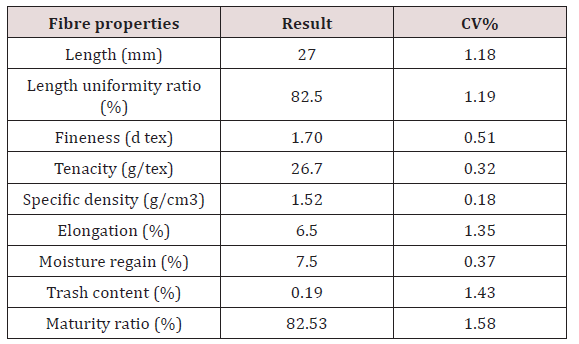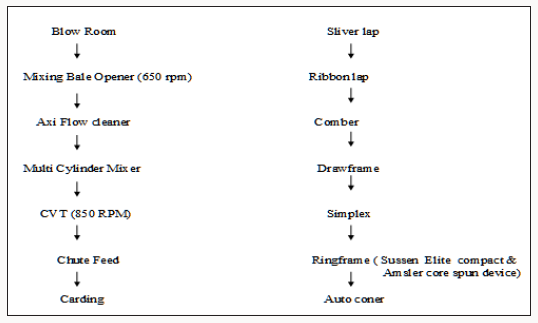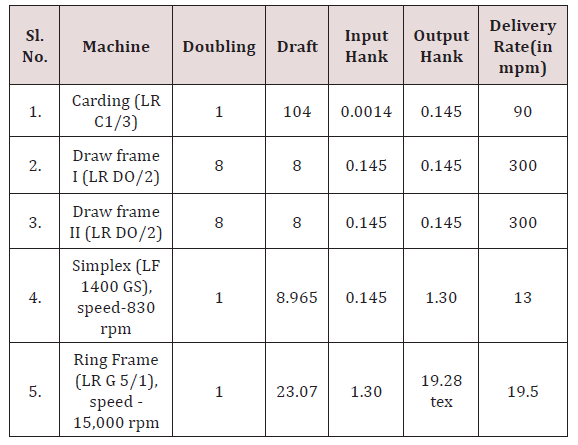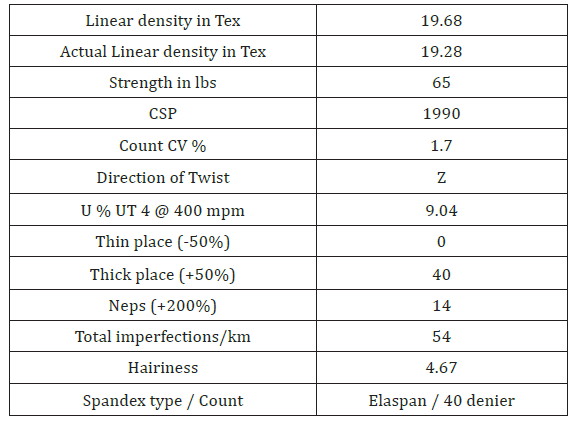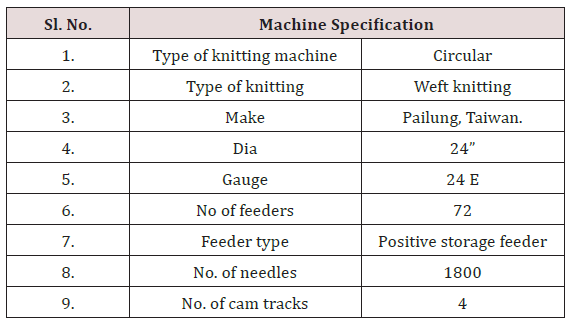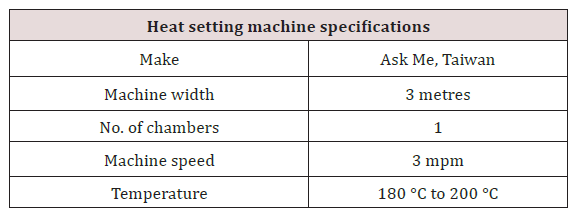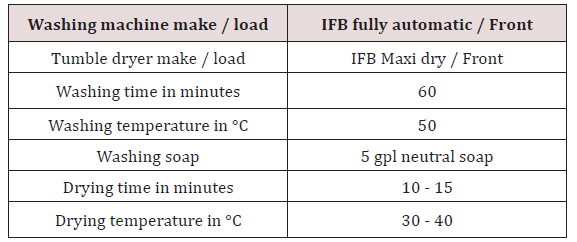
Lupine Publishers Group
Lupine Publishers
Menu
ISSN: 2637-4595
Research Article(ISSN: 2637-4595) 
Investigation on Geometric and Dimensional Properties of Cotton Sheath Elastomeric Core Spun Yarn Single Jersey and Popcorn Jersey Fabric Structures Volume 2 - Issue 1
V Kumar1, Guluma Sorsa1 and C Prakash*2
- 1Department of Textile Engineering, Wolkite University, Wolkite, Ethiopia
- 2Department of Fashion Technology, Sona College of Technology, Salem, India
Received: April 18, 2018; Published: April 26, 2018
*Corresponding author:C Prakash, Department of Fashion Technology, Sona College of Technology, Salem, India
DOI: 10.32474/LTTFD.2018.02.000129
Abstract
The prime purpose of this research work is to study the feasibility and the ease of knitting of cotton sheath - elastomeric core spun hosiery yarn into different fabric structures with the help of a modern multi cam track high speed circular weft knitting machine and comparing their geometric and dimensional properties. By keeping these objectives in mind, cotton sheath - elastomeric core hosiery yarn was spun. The produced spun yarn was knitted into two different fabric structures namely single jersey and popcorn jersey with identical machine parameters. Among these two fabric samples, the former one is a structure knitted with full of knit stitches and the latter one is the derivative structure of the former one and made up of the combination of knit and tucks stitches. Both these structures were subjected to their dry, wet and fully relaxed states and then their geometric properties were studied to understand the changes after each relaxation state and the potential of these structures to attain their dimensional equilibrium state was observed through repeated cycle of washing and drying. The comparison is pretty useful to understand the influence of tuck stitch into the geometric and dimensional characteristics of the popcorn fabric sample developed.
Keywords: Cotton Sheath-Elastomeric Core; Spun Hosiery Yarn; Tuck Stitch; Single Jersey; Popcorn Jersey; Loop Length.
Introduction
In knitting, the yarns are initially formed into loops, and then these loops are interconnected to produce a textile structure. The term inter looping is used to describe this technique of forming fabrics. Based on this principle, a textile fabric is produced by using only one set of yarn. Spencer [1] stated that knitting is one of the fabric forming methods in which the series of yarn loops are intermeshed to produce the fabric. Knitting is formed by a series of loops, intermeshing in rows, and each hanging from the last. Each intermeshed pair of loops is called as a stitch; a vertical column of stitches is a whale and a horizontal row of stitches is a course in a knitted fabric. Chandrasekhar [2] found that the term circular knitting covers all weft knitting machines have needle beds which are arranged in circular cylinders and or dials. Among global fabric production, circular knitting accounts for nearly 15%. Ajgaonkar [3] explained that majority of weft knitted structures are similar in four major structural units of construction, i.e. face knit stitch, back knit stitch, tuck stitch and float or miss stitch.
The most studied structure is plain-knit structure with full of knit stitches. It has proved, however, to be a difficult structure to analyse, mainly because of the experimental difficulty of measuring this highly extensible and easily deformable structure and also, it now appears, because its relaxed shape is not as simple to define as first thought. It is not possible to discuss the geometric and other properties of knitted fabrics without describing the elements of a knitted structure. The smallest element of a knitted fabric is the loop. During knitting the loop is extended due to take down force applied to the fabric. The fabric is removed from the knitting machine and left free from strain, and then the loop takes its original form. Doyle4 suggested that the knitted loop and the length of yarn knitted into the stitch in particular, is an important parameter for the measurement of knitted fabric quality. In a knitted structure the stitch density of fabric can be defined as the number of stitches per unit area of fabric and the mass per unit area of fabric is known as areal density. Usually, stitch density is measured in number of stitches present in square inch or square centimetre of weft knitted fabric.
In the same way areal density of weft knitted structure is estimated in number of grams per square metre of fabric (GSM). It has been found that the total number of stitches per square inch of fabric, is dependent primarily on the length of yarn per unit cell and is independent of yarn material, yarn structure, and the system used to form the stitches. Ajgaonkar [3] stated that in a knitted structure, apart from the plain stitch, other types of stitches may also be produced by varying the timing of the intermeshing sequence of the old and new loops. The most commonly produced stitches are the tuck stitch and miss stitch. Two or more miss stitches in sequence is called float. A tuck stitch is composed of a held loop, one or more tuck loops, and knitted loops. It is produced when a needle holding its loop also receives yarn to form a new loop which becomes a tuck loop because it is not intermeshed through the old loop, but is tucked in behind it on the reverse side of the stitch. Single jersey derivative structures such as pique, double pique, popcorn, Lacoste and cross tuck are better examples for knit and tuck stitch combination, cross miss is for knit and miss stitch combination , twill is for knit, tuck and miss stitch combination are the interesting outcome of these two fundamental derivative stitches of weft knitting.
The most convenient means of assessing the knitting performance of a spun yarn is by the use of the “tightness factor” concept. Munden [4-6] first expressed the use of a constant factor to indicate the relative tightness or looseness of a plain knit structure. Knapton [7] suggested that most spun yarn single knit fabric is commercially knitted between the range of 9 < K < 19. It is essentially impossible on any machine gauge or with any yarn count to knit fabric over a wider K range. A more usual knitting range, from loose to tight fabric is 12 < K < 18 with a mean value of 15. Doyle [8] had observed, when investigating the dimensional properties of plain-knitted fabrics, that for a wide range of fabrics, the product of the number of courses and Wales in unit area is dependent solely upon loop length. A further study by Munden [6] showed that the dimensions of plain knitted wool fabrics, in a state of minimum energy, were dependent only upon the length of yarn knitted into each loop. His experimental studies indicated that courses per unit length, Wales per unit length and loop length must be related to each other by constants such as Kc, Kw, Ks and K where c, w, s and K define the courses per inch, wales per inch, stitch density and tightness factor respectively. In general these constants are called “K-constants or fabric dimensional parameters”.
These constants are considered as the basic laws of knitted fabric structure, in that they indicate the dimensions towards which any plain-knitted structure tends in order to reach the state of equilibrium or minimum internal energy when knitted and removed from the machine. Moreover, they showed that there is only one factor which governs the dimensions of a knitted fabric known as loop length or stitch length. It means the length of the yarn knitted in to a loop. Their investigations on knitted fabrics and their tendency to reach a characteristic state of energy equilibrium have led to the realization that there are two basic equilibrium states for the knitted fabric, depending upon the treatment of the fabrics after knitting. These two states are known as the dry-relaxed state and the wet-relaxed state. If, after knitting, a fabric has been allowed to lie freely for a sufficient length of time, it may reach a stable state of equilibrium. This state is called a “dry relaxed state”. The state of equilibrium reached by a fabric after static relaxation in water and subsequent drying is called a “wet-relaxed state”. They expressed that the wet-relaxed K-values of non-hygroscopic yarns were essentially the same as the dry-relaxed values, though a 13- 15% difference in Ks value between the same relaxed states for fabrics knitted from hygroscopic yarns such as wool, cotton etc., was obvious.
Schulze [9] investigated the dimensional properties of single jersey, lactose and fleecy fabrics knitted with cotton - spandex yarns and reported that the weight and loop densities of cotton/spandex fabrics were higher than cotton fabrics; also the extension, both width wise and lengthwise, increased as the relaxation progressed. Tasmaci [10] found that variations are higher both in width wise and in weight for the spandex containing fabrics. The present day consumer demands fashionable garments, which offer comfort and style, stretch and flexibility, freedom and figure enhancement, as it as the tool of expressing personality. As far as comfort is concerned, cotton blends are more popular than pure cotton. All cotton garments may be comfortable but have wrinkle problems. Spandex comes here to help in offering wrinkle resistance and garment integrity while offering extra comfort. The wearer of spandex containing garment feels less fatigued and less muscle strain than the one wearing garment without spandex. This value of spandex is well recognized by the fabric and apparel manufacturers as well as the consumers.
The ongoing influence of casual clothing of life style is boosting the popularity of spandex containing garment. As casual work attire becomes more popular, spandex allows these types of garments more comfortable. Additionally, spandex provides a greater degree of wear ability, wrinkle recovery and crease retention, making it the perfect complement to the most garments. Thangamani and Natarajan [11] stated that durability and comfort are the two-yard sticks, which determine the sale ability of fabrics. Spandex is known for having elongation up to 700%. So, an ideal blend of cotton and spandex will help the fabric to have the advantages of both of them. In the air covering (intermingling) process, spandex is combined with cotton yarn, which is used for producing casual wear and aerobic wear. The garments made out of the fabrics consisting of spandex core spun (with spandex filament as core and other natural / man-made fibres as sheath), provide consistent shape, fit and comfort. These properties also help to develop the garments for “ready to wear”. Because of the above properties, spandex fibres are found in light weight and uses especially in swim wear, sportswear, light weight support garments, ladies inner wear etc., Prakash and Thangamani [12] observed that the dimension of fabrics containing spandex showed considerable change during their wet relaxation. Sadek [13] studied the effect of extension increase percent of bare lycra yarns during loop formation on the geometrical, physical and mechanical properties of plain jersey fabrics. Results showed a sharp increase in the courses density rather than the Wales density. Cuden [14] mentioned that the development of knitted fabrics with incorporated elastane has increased in recent decades. Knitting with these elasticized yarns usually results in a very compact structure.
Loop length is considered to be the primary parameter for knitted structures. Consequently, knowledge of all factors influencing loop length is vital for planning yarn consumption, comfort fit, quality, performance and aesthetic properties of knitted fabrics made from elasticized yarns. Kumar [15,16] investigated the suitability of cotton sheath elastomeric core spun yarn for circular knitting as an alternative for bare spandex feeding and the effect of loop length variables on the geometric properties of single jersey and double pique fabrics under different relaxation states. They also investigated the potential of the samples to attain their dimensionally stable state by subjecting the samples to repeated cycle of washing and drying and concluded that the fabric specimens reached a perfect state of dimensional equilibrium before five wash and dry cycles, and also the samples knitted with the smallest loop length reached its equilibrium quickly. In this research paper, valiant attempt has been made to study the effect of tuck stitches in the geometric and dimensional properties of the popcorn jersey fabric structure by comparing it with single jersey knitted under analogous production parameter.
Experimental Materials and Methodology
The materials used production methodologies of yarn and fabric samples, sample preparation for relaxation and testing, process flow, test procedures, and description of instruments used for testing are discussed elaborately under this title.
Production of Combed Hosiery Yarns
The raw material used for the production of fabric structures used in this research work is cotton sheath - elastomeric core spun hosiery yarn with nominal count 19.28 Tex. The said yarn is spun by using Amsler core spinning system which is able to jargonize elastomeric as core and cotton yarn as sheath (Table 1), (Figure 1), (Tables 2 & 3) provide an outlook to the readers about cotton fibre particulars, process flow sequence of machines used to spin the yarn, processing data of yarn and yarn properties respectively. The produced core spun yarn sample is knitted into single jersey and popcorn jersey structures in a multi cam track circular jersey knitting machine as specified in the Table 4 with uniform stitch length (i.e) 0.30 cm and the fabric tightness factor value 14.8. The fabric samples were developed as per the fabric sample plan given in Table 5.
Fabric tightness factor was estimated by using the following formula.
(Tex) 1/2
Tightness factor (K) = -------------------------------------- (1)
Loop length in cm
After knitting, the grey cut samples of both single jersey and popcorn jersey were kept flat and tension free for 48 hours under standard atmospheric condition (21±1 °C temperature and RH 65±2%) in a conditioning chamber to attain their first dry relaxed state (DRS I). Afterwards the geometric properties such as wale density, course density, stitch density, areal density were estimated and their respective constants such as Kw, Kc, Ks, and Kc/Kw were derived for both these samples.
Heat Setting and Second Dry Relaxation
The dry relaxed fabric samples were subjected to heat setting before coloration for stabilizing the elastomeric core portion present in their yarns. The heat setting machine specifications are given in Table 6. After heat setting, the grey samples were allowed for one more dry relaxation called DRS II under similar parameters of DRS I. Then the fabric samples were tested for their geometric properties such as wale density, course density, stitch density, areal density and their respective constants such as Kw, Kc, Ks, and Kc/ Kw were derived to know the effect of heat setting process.
Wet processing and wet relaxation
The heat set knitted fabric specimens were given wet processing pre-treatments such as scouring and subsequent bleaching with the help of a laboratory model soft-flow machine of 10 kg capacity.
The following scouring and bleaching recipe was adopted
(a) M:L ratio : 1: 10
(b) Wetting gent : 0.7%
(c) Lubricant : 0.5%
(d) Stabilizer : 0.5%
(e) Caustic soda : 3%
(f) Hydrogen Peroxide : 2.5%
(g) Temperature : 95°C
(h) Time : 60 minutes
(i) Peroxide killer : 0.7%
(j) Acetic acid : 1.0%
(k) pH : 6.5
(l) Temperature : 80°C
(m) Time : 30 minutes
The scoured and bleached samples were given a thorough hot wash at 60°C for 10 minutes followed by a cold wash at room temperature for 10 minutes and hydro extracted.
The fabric samples were dyed by using the recipe as mentioned below.
(a) Dye : Reactive H
(b) M:L ratio : 1: 10
(c) Salt : 35 gpl
(d) Black B : 1.7%
(e) Blue EDG : 0.90%
(f) Red MEABL : 0.45%
(g) Soda ash : 20 gpl
(h) temperature : 70°C - 80
The dyed knitted fabric samples were subjected to a hot wash at 60°C for 15 minutes followed by a cold wash at room temperature for 10 minutes to remove the excess adhered colour from the surface. The washed fabric samples were hydro extracted and applied with softener to improve the surface feel and dried with the help of relaxes dryer. A portion of dyed fabric samples were immersed in a stainless steel water bath containing 0.05 gpl standard wetting agent with water temperature maintained at about 37°C and allowed to relax with very mild agitation for 24 hours. Samples were then hydro-extracted for 1 minute and laid on a flat surface for 48 hours. Samples were brought back to the conditioning chamber with standard atmospheric condition of 21 ± 1°C at a RH 65 ± 2 % and kept flat for 48 hours, free of tension to obtain the wet relaxed state (WRS). After wet relaxation the changes occurred in the geometric properties of the fabric samples such as wale density, course density, stitch density, areal density were observed and recorded and their respective constants such as Kw, Kc, Ks, and Kc/Kw were also derived and noted down.
Repeated Cycles of Washing And Drying and Fully Relaxation
From each WRS fabric structure, 5 square fabric samples of 70 cm X 70 cm were cut. All the cut samples were marked in three adjacent positions in length as well as in width by using the standard template. The straight in-between distance of each length way as well as width way marking is 50 cm. These samples were subjected to five repeated cycle of wash and dry for studying the dimensional changes. The percentage of dimensional changes in the sample after every wash and dry is observed and noted with the help of a specially designed direct shrinkage and growth percentage measuring scale. The noted down values after every cycle were useful to understand the potential of the individual fabric sample to reach its dimensional equilibrium state called dimensional stability. The repeated cycles of washing and drying of fabric samples were carried out with the help of a standard fully automatic washing machine and tumble dryer with specification given below in the Table 7.
The knit fabric samples of repeated cycle of washing and drying were then laid on the flat surface of a conditioning chamber with standard atmospheric condition of 21 ± 1 °C at a RH 65 ± 2 % for 48 hours free of tension. During this period the samples tend to reach their dimensionally equilibrium state and minimum energy level called fully relaxed state (FRS). At this stage the changes took place in the geometric properties of the knit fabric samples were estimated and recorded along with their constants. All the relaxation treatments were carried out as per ASTM D 1284-76 test procedure.
Testing procedure of geometric properties of knitted fabric
The estimation of geometric properties of knitted fabrics such as wale density and course density (ASTM D 3887: 1996 (RA 2008)), loop length (ASTM D 3887) and areal density (ASTM D 3776) were carried out in single jersey and popcorn jersey specimens in all three relaxation states. For the measurement of wale density and course density 1” X 1” square was marked on single jersey and popcorn samples in 10 different places apiece. After that the wale density was counted with utmost care by using a thread magnifying glass in all the 10 places of both the samples and noted. After that, the mean value of wale density was estimated. In single jersey sample, the course density was measured with utmost care by using a thread magnifying glass in all the 10 places and noted. Afterwards, the mean value of that was estimated. But, the popcorn jersey is a fabric knitted with courses of knit and tuck along with all knit courses and hence direct counting of course density does not give accurate results. So, 10 marked samples from this fabric was cut and unravelled course wise to estimate the course density and it’s mean.
The loop length was measured by unravelling 10 courses each with 100 Wales (adjacent loops) and the total length of each course was measured. The average loop length or stitch length was calculated by using the simple formula i.e. total length of 100 Wales in cm /100 to obtain the length of one loop in cm from a course. The same way the loop length is obtained for all the ten courses and the average value was calculated for every sample. The areal density of the knitted fabrics was measured by cutting the sample with area of 100 cm2 by using a standard circu-cutter. The cut sample was weighed in the electronic balance and the resultant value was multiplied by 100 to get the GSM. Thus 10 specimens were tested from each sample and the average value was estimated.
Results and Discussion
Table 8 Comparison of geometric properties of CSJER and CSPOP samples at various DRS - Dry Relaxed State, WRS-Wet Relaxed State, FRS-Fully Relaxed State, CSJER -Single Jersey, CSPOP -Popcorn Jersey, l- Stitch Length, cm - Centimetre WPI - Wales per Inch, CPI - Courses per Inch, Kw - Wales Constant, Kc - Course Constant, S - Stitch Density, Ks - Stitch Density Constant, Kc/Kw - Loop Shape Factor, K-Tightness Factor, GSM - Areal Density in grams per metre.
Comparison on geometric properties of single jersey and popcorn jersey
Wale density:From the Table 8 in between DRS I and DRS II uniform increment in the wale density is noticed for both the structures. This value is dropped slightly for both single jersey and popcorn jersey between DRS II and WRS. But, in between WRS and FRS small increase in the wale density value is observed for both single jersey and popcorn jersey samples. Anyhow, the wale density values of single jersey sample are slightly on the higher side when compared to the popcorn jersey in all the relaxation states. It may due to the presence of tuck stitches at regular intervals in popcorn jersey structure and the legs of the tuck stitches widened the gap between the adjacent Wales.
Course density:A prominent increase in the course density is highlighted for both single jersey and popcorn jersey samples after every state of relaxation. But, the course density value of popcorn jersey structure is found significantly higher than the single jersey in all the relaxation states. In the popcorn jersey structure, the presence of three consecutive tuck stitches of three adjacent courses before and after an all knit course may instigate the lengthwise contraction in the sample and the corresponding increase in the course density.
Areal density:It is evident from the observation that the presence of tuck stitches has caused significant increase in the course density value and the thickness of the popcorn jersey fabric sample even though both the samples are knitted with similar stitch length. As a result of this popcorn jersey sample is found with higher areal density during all the fabric relaxation states than its counterpart.
Thickness:The occurrence of continuous trio of inverted ‘V’ shaped tuck stitches once in every four courses has caused the popcorn jersey fabric to appear with more thickness than all knit stitched single jersey during each progressive state of relaxation. It is evident from the thickness test results depicted in Table 8. The thickness increase is found common in both the fabric samples during every relaxation state. It may be the outcome of contraction of these samples during progressive relaxation states.
Knit fabric constants:Table 8 shows a range of knit fabric constants such as Kw, Kc, Ks, K and Kc/Kw. All these constants are arrived based on the research work carried out on cotton and wool circular weft knitting by yester year workers. Further elaborative research is required in this area for the contemporary circular weft knitted fabrics produced from a wide range of new fibres / yarns etc.
Table 9 clearly depicts the potential of the fabric samples CSJER and CSPOP to attain their dimensional equilibrium state when subjected to repeated cycle of washing and drying. After every cycle of washing and drying, the lengthwise and width wise change in the samples is assessed. If the growth% or shrinkage% is within the range of + 5% for three consecutive washes then the sample can be assumed as attaining its minimum potential level. Both the samples have reached their width wise dimensionally stable state after the first washing and drying it-self and in lengthwise after the second washing and drying cycle. From the results, it is evident that the dimensional stability of a knitted fabric sample depends greatly on its stitch length and tightness factor. The stitch configuration of a fabric structure does not have any significant importance in deciding its dimensional stability.
Conclusion
The knitting performance of cotton sheath elastomeric core spun yarn is noticed uniformly satisfactory for both single jersey and popcorn jersey. The wale density values of popcorn jersey are found lower in all the relaxation states than its counterpart. The reason for this effect is the pushing of knit loops in the course by the adjacent tuck stitches. At the same time, the course density of the popcorn jersey is seen with higher values in all the relaxation states due to lengthwise contraction of the sample due to the presence of sequence of lengthwise tuck stitches. The areal density and the thickness of popcorn jersey are found higher due to the accumulation of tuck stitches. Stitch configuration does not play any role in deciding the dimensional stability of both single jersey and popcorn jersey fabric samples. It is the property very much based on stitch length and fabric tightness factor.
References
- Spencer D J (2001) Knitting Technology, A comprehensive handbook and practical guide (Woodhead Publishing Limited, England) 4.
- Chandrasekhar I, Bernd M Wolfgang S, Bamberg (1995) 12-21.
- Ajgaonkar DB (1998) Knitting Technology (Universal Book Corporation, Mumbai India) 13.
- Munden DL (1959) J Text Inst 51: 200-209.
- Munden, DL (1959) J Text Inst 50: 448-471.
- Munden DL, Leigh BG Chell FN, (1963) J Text Inst 54: 135-145.
- Knapton JJF, Athrens FJ, Ingenthron WW, Fong W (1968) Text Res J 38: 999-1012.
- Doyle PJ (1953) J Text Inst 44: 561-578.
- Schulze U (1993) Wirkerei Strickerei Tech 5: 456-459.
- Tasmaci M (1996) Tekst Konfeksion 6: 422-426.
- Thangamani K, Natarajan V (2003) Proceedings, 2nd Indo-Czech Textile Research Conference (Kumaraguru College of Technology, Coimbatore) 97.
- Prakash C , Thangamani K (2010) Indian J Sci Tech 3: 287-289
- Sadek R, El Hossini AM, Eldeeb AS, Yassen AA (2012) J Eng Fiber Fabr, 7:11-16.
- Cuden AP, Hladnik A , Sluga F (2012) Text Res J 83:56-65.
- Kumar V, Sampath VR, (2013) Fibres Text East Eur 3: 73-75.
- Kumar V, Sampath VR , Vigneswaran C, (2014) J Text Apparel Tech Manage 8: 1-13.

Top Editors
-

Mark E Smith
Bio chemistry
University of Texas Medical Branch, USA -

Lawrence A Presley
Department of Criminal Justice
Liberty University, USA -

Thomas W Miller
Department of Psychiatry
University of Kentucky, USA -

Gjumrakch Aliev
Department of Medicine
Gally International Biomedical Research & Consulting LLC, USA -

Christopher Bryant
Department of Urbanisation and Agricultural
Montreal university, USA -

Robert William Frare
Oral & Maxillofacial Pathology
New York University, USA -

Rudolph Modesto Navari
Gastroenterology and Hepatology
University of Alabama, UK -

Andrew Hague
Department of Medicine
Universities of Bradford, UK -

George Gregory Buttigieg
Maltese College of Obstetrics and Gynaecology, Europe -

Chen-Hsiung Yeh
Oncology
Circulogene Theranostics, England -
.png)
Emilio Bucio-Carrillo
Radiation Chemistry
National University of Mexico, USA -
.jpg)
Casey J Grenier
Analytical Chemistry
Wentworth Institute of Technology, USA -
Hany Atalah
Minimally Invasive Surgery
Mercer University school of Medicine, USA -

Abu-Hussein Muhamad
Pediatric Dentistry
University of Athens , Greece

The annual scholar awards from Lupine Publishers honor a selected number Read More...







